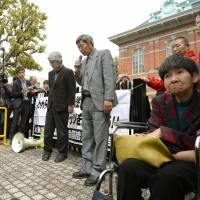The Kumamoto District Court on Monday ordered the state, the Kumamoto Prefectural Government and Chisso Corp. to pay damages to three of eight unrecognized Minamata disease sufferers who sued them.
In ruling on the ¥212 million damages suit, the court ordered the payment of ¥106 million in damages, including a record-high ¥100 million for one of the three victims as demanded by the plaintiff.
After the ruling, however, lawyers for the plaintiffs said they effectively lost because the court rejected damages for five of the eight plaintiffs.
The eight are men and women aged 54 to 61 who were born in Kumamoto and neighboring Kagoshima around 1956, when health authorities officially recognized the existence of Minamata disease in Kumamoto Prefecture.
The eight, who complain of paresthesia (a "pins and needles" feeling) in their limbs, had applied with two prefectural governments for recognition as Minamata disease patients but were rejected or left in limbo.
Their lawyers argued that they had a history of mercury intake and contracted mercury-caused paresthesia. The defendants denied it.
The damages were mostly in line with the minimum damages amount of ¥16 million agreed to by Chisso, which caused the mercury-poisoning disease, and officially recognized Minamata patients.
In previous suits over the disease, the Supreme Court in October 2004 upheld an Osaka High Court decision that ordered the payment ¥4 million to ¥8 million each for plaintiffs in the Kansai region, recognizing wider damages from the state's then guidelines for recognizing patients.
In suits over recognition of Minamata patients, the top court in April last year upheld a high court ruling that posthumously recognized a woman who had complained of paresthesia blamed on the disease.




